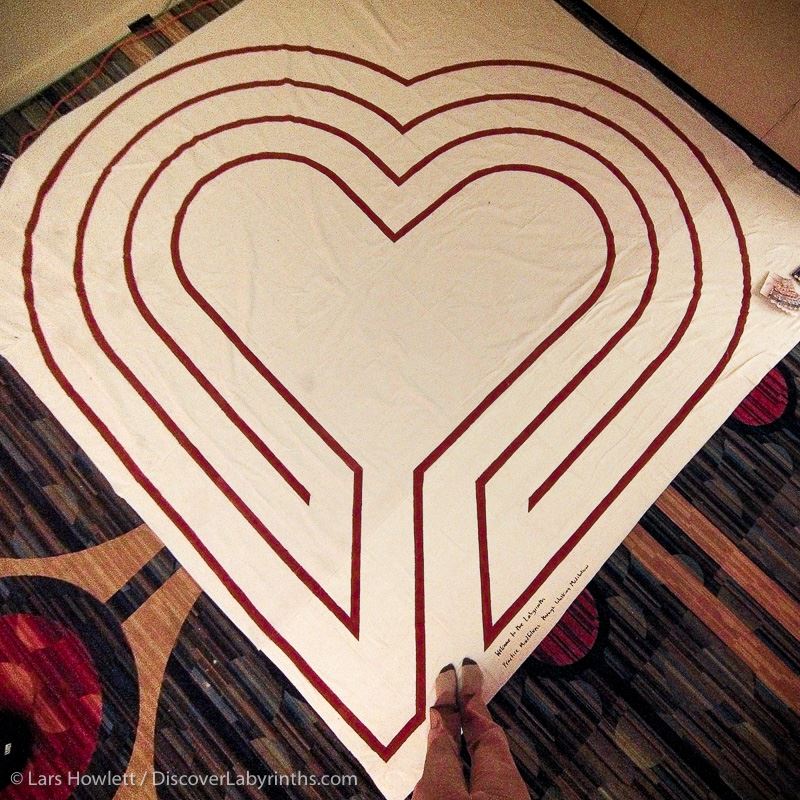
Considerations for Labyrinth Construction
A labyrinth should stir the heart of the community for which it is created. To learn how to install an effective labyrinth, walk as many labyrinths possible. (You can search the Labyrinth Locator for local sites.) Consider the variety of patterns, materials, venues, sizes, and conditions on your visits. Consider attending Labyrinth Summer School to learn the history, design and methods of constructing labyrinths and get feedback on your ideas from a master builder. Five questions to ask before constructing a labyrinth:
What is an "effective" labyrinth?"The extent to which labyrinths are considered effective is directly connected with the experience they engender, the emotions and insights they ignite, the sense of calm or Presence they evoke, the depth of solace they bring and the activation of our interior symbolic realms that they stir." – Lauren Artress (Walking a Sacred Path, 2nd Ed., p. 180) Archetypal and Contemporary LabyrinthsArchetypal labyrinths come from ancient roots. The Classical 7-Circuit Labyrinth is 4,000+ years old. Variations on this design were found in Western Europe, the Mediterranean, Scandinavia, India, and North Africa.
When newcomers encounter the labyrinth, many are eager to change these ancient designs and do so without an appreciation as to how effective labyrinths work. They do not realize that these archetypal designs were intentionally created to stir the human heart and order the chaos in the collective. "The Labyrinth is an ancient symbol, a collectively and anonymously fashioned design, shaped and given fuller meaning over time by hundreds of generations. This fails to comply with the modern notion of the individual genius of an artist being unique and free, coming from within, and being beholden only to oneself. Indeed, collective, anonymous experience and individual probings clash with one another." (Hermann Kern, Through the Labyrinth, p. 305) |
Professional GuidanceVeriditas recommends professional Labyrinth Designer and Master Builder Lars Howlett for projects in the San Francisco Bay Area and beyond. Lars is a Veriditas Faculty Member who leads design theory and construction classes at Labyrinth Summer School. He is the former apprentice to Robert Ferré, inheriting his tools, techniques, teaching curriculum, and research library.Operating as Discover Labyrinths LLC, Lars creates Classical variants or exact replicas of Medieval Labyrinths using Sacred Geometry and firsthand research from historic sites around the world. Whether temporary or permanent, found objects or big budget, improvised or precise, Lars both honors tradition and leads a new generation in creating labyrinths around the globe. Complete this form for a free 20-minute consultation by phone, email or video conference. Lars is also available for site visits, custom design, photo research, guidance on materials/installation, and drafting proposals and estimates to realize your vision. Mention Veriditas as your referral and a portion of the proceeds will help support our non-profit. “The hope of every master teacher is for the student to no longer need him. That is certainly the case with Lars, who went through a highly technical apprenticeship with me and has gone on to be a capable and creative labyrinth maker on his own. In many areas he has surpassed my own skills. I highly recommend Lars without reservation.” – Robert Ferré Facilitator TrainingOnce a labyrinth has been built, we often get requests as to how to create a program to use it. Our research shows that when there is not a knowledgeable 'point' person on site, the labyrinth is used less often.Veriditas Labyrinth Facilitators are trained under the premise ‘To Facilitate a Labyrinth is to Walk a Spiritual Path.’ This two-day training, taught by Lauren Artress or one of our Master Teachers, offers guidance to present professional quality labyrinth events and prepares presenters to receive the profound depth that the labyrinth can awaken. Click to learn how to become a Veriditas Labyrinth Facilitator. Click here to learn how to become a Veriditas Labyrinth Facilitator. |




